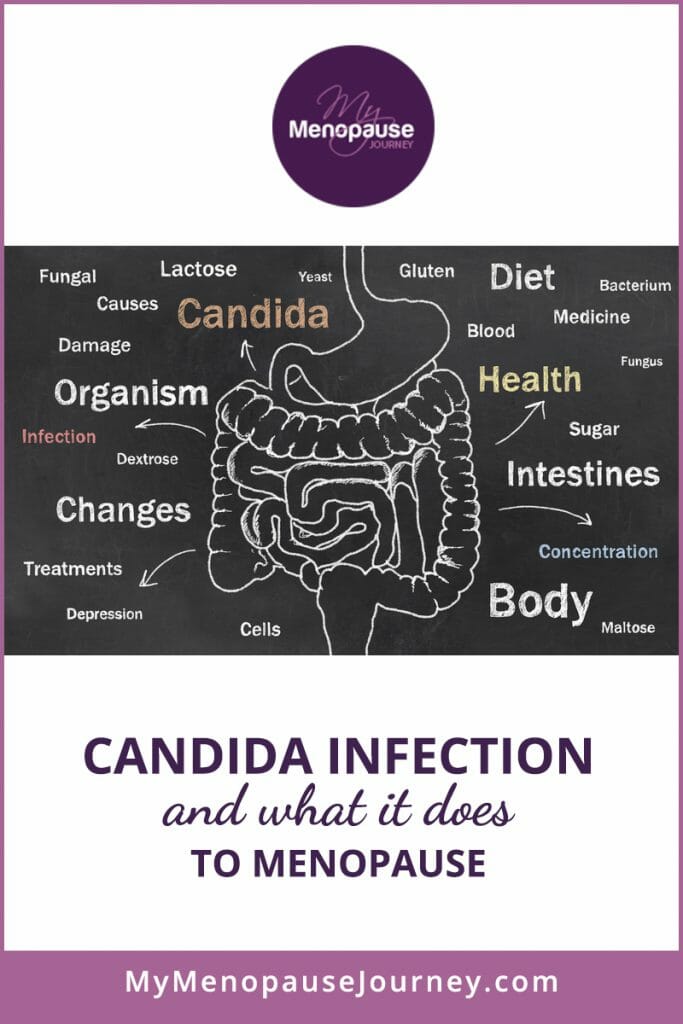Been waking up feeling foggy?
Or feeling like your belly is puffy again?
Or maybe you can’t stop craving something sweet while your mood is all over the place.
I know it’s easy to chalk this up to “yup, just menopause”…
But what if something deeper — like yeast overgrowth — is behind the scenes?
Here’s a truth I wish someone had told me sooner:
Candida and yeast infections are more common in menopause than most women realize. And they can be sneaky.
Candida might be the quiet force behind your itching, bloating, cravings, energy crashes, and even that stubborn fatigue you can’t explain.
For some, it shows up as recurring yeast infections. For others, it hides deeper in the gut, fueling inflammation and throwing your hormones into a tizzy.
So, let’s pull back the curtain on this misunderstood yeast — and explore how shifting hormones make us more vulnerable to it in midlife.


What Is Candida (and Why It Flares Up in Menopause)?
Candida albicans is a type of yeast that naturally lives in your body. It’s not inherently bad. In fact, when your gut flora is balanced, candida plays a helpful role — assisting with digestion, nutrient absorption and immune signaling.
But the hormonal changes in menopause can change your gut terrain. And when candida senses an opportunity (like high estrogen, high cortisol or excess sugar, it multiplies fast. Too fast actually.
That’s when the trouble starts.
Toxins build up, digestion stalls, inflammation takes root, and your body starts sending distress signals!
We don’t always connect the dots — but the symptoms ARE there.
️How Do We Know It’s Candida? Here are the Symptoms to Watch For
Candida isn’t always just about vaginal itching (although that’s one of the most common signs for women in midlife).
Systemic candida overgrowth can show up as:
- Intense sugar or carb cravings
- Brain fog
- Gas, bloating, constipation or loose stools
- Chronic fatigue
- Mood swings or irritability
- Joint pain or muscle aches
- Dizziness or headaches
- Skin problems (rashes, scaling, itching, swelling)
- Recurring UTIs or yeast infections
- Trouble sleeping
Sounds familiar? If you’re nodding, candida might be involved.
You don’t need to guess, though! There are at-home ways to test — like pH strips or spit tests (yes, really). And if you want more guaranteed confirmation to rule things out, stool or blood tests can help, too.
What Triggers Candida Overgrowth in Menopause?
Now that’s the question! Many disruptors tend to tip gut balance in midlife and, in turn, lead to candida overgrowth:
Hormonal shifts – High estrogen, low progesterone, or HRT (when done without careful consideration of your individual needs) can all increase susceptibility
Sugar overload – Candida feeds on sugar, including “hidden” sugars in bread, pasta, processed snacks, beverages, sauces, condiments and even certain fruits.
Stress – Long-term stress weakens your innate immunity, spikes glucose levels and throws your gut health off balance.
Poor gut health – Low stomach acid, gut problems that affect your natural metabolic rhythm, and weak microbiome defenses all play a role.
Antibiotics or NSAIDs – These can wipe out good bacteria and damage your gut lining.
Tight, damp clothing – Especially synthetic underwear or workout gear that traps moisture in the intimate area.
Keep in mind that candida doesn’t need much to overtake the gut, skin, or reproductive tract. That’s why prevention and daily care are super important!
Candida and Menopause: What’s the Real Connection?
Menopause does not directly cause candida overgrowth. But since candida loves estrogen, women tend to be more vulnerable to the infection as they hit midlife!
Studies show that estradiol — the form of estrogen that spikes and dips wildly during menopause — feeds yeast growth and suppresses the vaginal immune barrier.
At the same time, your protective hormone, progesterone, begins to fade in perimenopause. And with that decline, your natural resistance to infection weakens, too.
All this hormonal chaos — especially if you’re dealing with estrogen dominance — makes your internal environment more acidic. And candida thrives in that!
Your sugar metabolism speeds up, pH shifts, and suddenly you’re the perfect host.
Toss in stress (which raises cortisol and blood sugar), antibiotics (which kill friendly flora), or a few nights of poor sleep — and candida sees a shining opportunity to throw some messy party!
Your Three-Step Candida Reset — the Natural Way!
Let’s keep it simple but powerful. Here’s how I’ve approached candida with the ladies I’ve worked with — and with myself back when I almost hosted the party:
STEP 1: Starve It.
As we’ve tackled, candida feeds on sugar. To reset:
→ Cut back or eliminate processed foods, alcohol, dried fruits, and refined grains.
→ Focus on clean proteins, non-starchy veggies, good fats (olive oil, coconut oil), and fermented foods.
→ Sip on bone broth to soothe and rebuild the gut lining
→ Avoid all types of sugar (it can hide in many different aliases)!
This isn’t forever; you don’t have to feel deprived or controlled. But this is an essential step to kickstart your reset!
STEP 2: Crush It.
Nature gives us allies to fight candida directly:
→ Antifungal herbs: oregano, garlic, clove, turmeric, thyme, and olive leaf
→ Teas and tinctures: peppermint, fennel, and cinnamon support detox
→ Probiotics: crowd out yeast and reinforce the gut wall
→ Digestive support: consider bitters or enzymes if digestion feels sluggish
Rotate herbs to avoid resistance. Your body is wise — just give it the right tools!
STEP 3: Rebuild Your Gut Guardians.
Once the fire is out, focus on restoration:
→ Repopulate good flora: sauerkraut, kimchi, kefir, or a quality supplement
→ Support liver detox: dandelion, milk thistle, or a gentle liver cleanse
→ Nourish: prioritize sleep, manage stress, walk in the sun, reconnect with nature, get intimate!
Remember, candida (and many other gut bacteria) is part of you — not a villain.
But in menopause, the goal is balance. You’re not fighting your body. You’re working with it!
Final Thoughts…
If you’re living in a fog of bloat, cravings, irritability, and fatigue… and nothing seems to help — it’s worth asking if candida or recurring yeast infections are part of the picture.
It’s not weird. It’s not shameful. And most importantly, it is reversible.
As your hormones shift in midlife, your body becomes more sensitive to everything — from the food you eat to the stress you carry. Candida overgrowth is just one layer — but when you clear it, other symptoms often lose their grip too.
And if you’re tired of piecing it all together on your own…
If you want a real structure — not just random tips — to finally calm your gut, steady your hormones, and feel lighter in your own skin again…
Check out FAST.EAT.THRIVE™.
It’s the exact rhythm I use with women in midlife who are ready to get off the symptom rollercoaster.
Inside, I’ll guide you step by step — with doable, gut-loving, hormone-balancing tools that actually move the needle.
Because you don’t need another “fix.”
You need a rhythm that works with your body — not against it.
Frequently Asked Questions About Yeast Infections and Candida in Menopause
Q: Are yeast infections more common during menopause?
Yes. Hormonal shifts — especially fluctuating estrogen and declining progesterone — can weaken your body’s natural defenses, making you more prone to yeast overgrowth. Many women also experience gut imbalance, stress, and blood sugar issues in midlife, which candida loves to feed on.
Q: What are the symptoms of candida overgrowth in menopause?
Symptoms can go beyond itching. You might feel bloated, foggy, moody, or constantly crave sugar. Recurring vaginal yeast infections, fatigue, skin rashes, or digestive troubles (like gas or constipation) can also point to candida overgrowth in midlife.
Q: What causes candida to overgrow during menopause?
The big triggers? Hormonal chaos, sugar-heavy diets, chronic stress, and a weakened gut microbiome. Add antibiotics, poor sleep, or tight clothing, and candida gets the perfect environment to grow — especially when estrogen levels spike or dip unpredictably.
Q: How can I treat candida or yeast infections naturally in menopause?
Start by cutting back on sugar and processed carbs. Support your gut with fermented foods, antifungal herbs (like oregano, garlic, and clove), and quality probiotics. Restoring your gut terrain and calming your hormones is key — which is exactly what I guide you through inside FAST.EAT.THRIVE™.
Q: Is candida the same as a yeast infection?
Yes — most vaginal yeast infections are caused by Candida albicans. But candida can also show up elsewhere in the body: the gut, skin, sinuses, and more. In menopause, both vaginal and systemic candida overgrowth can be more common than we’re told.
References:
link.springer.com/article/10.1007/s11908-023-00801-z
ncbi.nlm.nih.gov/books/NBK549797/
cdc.gov/candidiasis/signs-symptoms/index.html
pmc.ncbi.nlm.nih.gov/articles/PMC5770522/
womenshealth.gov/a-z-topics/vaginal-yeast-infections
msdmanuals.com/home/women-s-health-issues/vaginitis-cervicitis-and-pelvic-inflammatory-disease/vaginal-yeast-infection-candidiasis
msdmanuals.com/home/skin-disorders/fungal-skin-infections/candidiasis-yeast-infection


Gita is the founder of My Menopause Journey. Since 2014, she has been supporting midlife women by sharing hard-earned learnings from her own experience. To advance her knowledge, Gita puts a lot of her time and effort into understanding the broad spectrum of women’s health. She immerses in extensive research about the physical, mental and emotional aspects of menopause. Gita believes in the life-changing power of healthy, holistic living — this is where she anchors her message to all women. Learn more about her marvelous mission in About us - My Menopause Journey.




